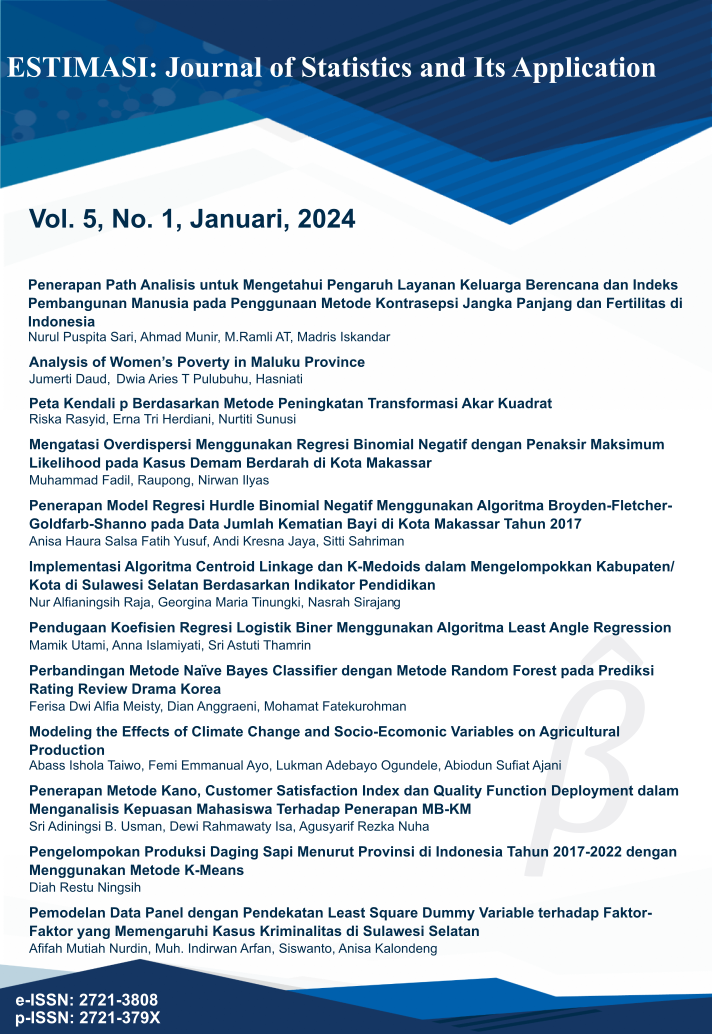Penerapan Metode Kano, Customer Satisfaction Index dan Quality Function Deployment dalam Menganalisis Kepuasan Mahasiswa Terhadap Penerapan MB-KM
Keywords:
Kano, Customer Satisfaction Index, Quality Function Deployment, MB-KM, InternshipAbstract
The implementation of the MB-KM program in Higher Education has a variety of obstacles based on points of view. Internship is a form of implementing the MB-KM program which involves students as executors of the program. This study aims to analyze student satisfaction with the implementation of MB-KM using the Kano method, Customer Satisfaction Index (CSI) and Quality Function Deployment (QFD). The Kano method aims to categorize variable attributes, the CSI method to calculate the overall level of satisfaction and the QFD to determine priority attribute improvements. Kano's results show that 5 attributes are in quadrant A, 30 attributes are in quadrant O, 5 attributes are in quadrant I and 13 attributes are in quadrant M. The results of the analysis of the Customer Satisfaction Index are 87.57% meaning students are "very satisfied". The final result of the HOQ attribute that is the priority is attribute .
References
Direktorat Jenderal Pendidikan Tinggi, Buku Panduan Merdeka Belajar-Kampus Merdeka. Jakarta: Kementerian Pendidikan, Kebudayaan, dan Pendidikan Tinggi, 2020.
Bhakti, Y. B., Simorangkir, M. R. R., Tjalla, A., & Sutisna, A. Kendala Implementasi Kebijakan Merdeka Belajar Kampus Merdeka (Mbkm) Di Perguruan Tinggi. Res. Dev. J. Educ., 8(2), 783, 2022, doi: 10.30998/rdje.v8i2.12865.
Junaidi, A. Panduan Penyusunan Kurikulum Pendidikan Tinggi. 2020.
Bakhtiar, A., Susanty, A., & Massay, F. Analisis Kualitas Pelayanan Yang Berpengaruh Terhadap Kepuasan Pelanggan Menggunakan Metode Servqual Dan Model Kano (Studi Kasus: PT. PLN UPJ Semarang Selatan). J@TI Undip, 5(2), 77–84, 2010.
Kusbiyantoro, R., & Achmadi, F. Analisis Perbaikan Kualitas Kertas Art Paper Di Pt. Pabrik Kertas Tjiwi Kimia Tbk Berdasarkan Customer Satisfaction Index (Csi) Dan Quality Function Deployment (Qfd). Semin. Nas. IENACO, 2017.
Yushila, A. B., Effendi, M., & Effendi, U. Analisis Kepuasan Konsumen Dengan Metode Fuzzy – Servqual Dan Quality Function Deployment (Studi Kasus Café Right Time Malang). J. Teknol. Pertan., 18(2), 107–118, 2017, [Online]. Available: https://jtp.ub.ac.id/index.php/jtp/article/view/583/925
Fatahilah, A., Trismawati, T., & Prihatiningsih, T. Analisis Kepuasan Pelanggan Terhadap Hasil Pengembangan Produk Lampu Rumah Dengan Metode Quality Function Deployment (Qfd) Achmad. 20–26, 2019.
Hutabri, E. Penerapan Metode Kano Dalam Analisis Tingkat Kepuasan Mahasiswa Terhadap Penerepan Sistem Informasi Akademik Berbasis Web. Edik Inform, 1(2), 55–63, 2017, doi: 10.22202/ei.2015.v1i2.1425.
Yuwono, R., & Yuamita, F. Analisa Faktor K3 dan Ergonomi Terhadap Fasilitas Pusat Kesehatan Universitas Untuk Mengukur Kepuasan Pasien. J. Ilm. Tek. Ind., 14(1), 1–12, 2015.
Heryanto, C. A. W., Korangbuku, C. S. F., Djeen, M. I. A., & Widayati, A. Pengembangan dan Validasi Kuesioner untuk Mengukur Penggunaan Internet dan Media Sosial dalam Pelayanan Kefarmasian. Indones. J. Clin. Pharm., 8(3), 2019, doi: 10.15416/ijcp.2019.8.3.175.
Nesa, R. S. E., Wirastuti, N. M. A. E., & ER, N. I. Tingkat Kepuasan Pengguna Website www.unud.ac.id. 2(2), pp. 128–134, 2015.
Putri, A. M. Penerapan Model Kano Pada Analisis Kepuasan Pengunjung Perpustakaan Institut Pertanian Bogor Terhadap Fasilitas dan Pelayanan. 2016.
Downloads
Published
Issue
Section
License
Copyright
It is the author's responsibility to ensure that his or her submitted work does not infringe any existing copyright. Authors should obtain permission to reproduce or adapt copyrighted material and provide evidence of approval upon submitting the final version of a manuscript.


